Life Extension Magazine®

Rapamycin is a drug that extends lifespan in virtually every animal tested.1-4 It may also protect against age-related diseases.5-9
In 2016, CNN aired a broadcast showing an old dog behaving like a young dog after taking rapamycin.10
Animal studies show 50-60% lifespan increases in response to rapamycin. This prompted the National Institutes of Health to fund a $23 million study of 10,000 pet dogs.11,12 Rapamycin will be given to 500 of the dogs.
Scientists will then evaluate healthspans and conduct genetic testing to identify what biological mechanisms are responsible for rapamycin’s benefits. The pet dogs will stay at home and be cared for by their owners, which is more humane and realistic than keeping them in kennels.
Rapamycin’s anti-aging properties include suppressing excess signaling of a cellular protein called mTOR.13
When mTOR activity is constantly elevated, it increases risk of degenerative disorders.14
A complication of excess mTOR signaling is inhibition of a cellular housekeeping process called autophagy.14
Autophagy is nature’s way of clearing damaged proteins, stored fat, and other waste products inside our cells.15,16
Almost every intervention shown to extend healthy longevity involves activation of autophagy (removing toxic cellular waste).17,18
This article will describe how everyone can easily improve their cellular housekeeping.
Autophagy is the body’s self-cleaning process that removes damaged byproducts from inside cells that accumulate from normal metabolic processes.
Insufficient autophagy is a driver of aging and degenerative illnesses.17,18
Restoring balanced autophagy is a critical factor in reversing systemic degeneration.17
Most Life Extension® readers turn on beneficial autophagy by using AMPK activators, and NAD+ precursors, and by cutting back on excess calories.
Those who engage in intermittent fasting, be it avoiding food for 16-18 hours most days, or fasting two days a week, are cleansing their cells via activation of autophagy.19
People are participating in clinical trials evaluating the autophagy-enhancing effects of rapamycin and its potential to induce systemic rejuvenation.20-27
We eagerly look forward to the results of these rapamycin studies but people today need real-world solutions.
A novel approach has been developed to enhance more youthful autophagy. The objective is to enable aging individuals to cleanse their cells of toxic debris.
Autophagy Declines with Age
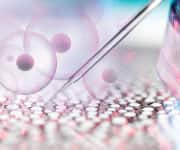
Young cells remove metabolic waste products so they can operate at optimal efficiency.
However, even in youth, chronic ingestion of high calorie diets (three large meals a day + snacking in between) may preclude effective autophagy. This might help explain why more younger people are developing metabolic disorders such as obesity and type II diabetes.
Incidences of heart failure in people under age 65 are rising.28 This is largely a result of the obesity epidemic.
Accumulation of unwanted body fat is partially caused by excess mTOR that turns down autophagy’s natural removal of cellular fat, damaged proteins, and other metabolic waste.29
Normal aging results in autophagy decline unless interventions are initiated such as intermittent fasting and/or aggressive exercise.
Fortunately, there are natural ways to improve autophagy even in those who don’t follow optimal dietary and physical-activity programs.
Effect of Luteolin On Autophagy
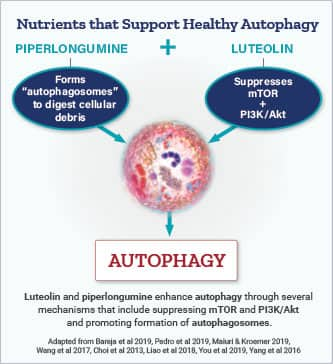
A plant flavonoid called luteolin was identified by Life Extension ® in 1985 as a potential anti-cancer supplement.30
Found in celery, broccoli, green pepper, parsley, and thyme, luteolin demonstrated cancer prevention properties in animal and cell studies.31,32
Associations have been found between diets rich in flavonoid-containing plant foods and lower cancer rates.33
The challenge in 1985 and in recent years was finding an affordable source of supplemental luteolin.
That roadblock has been resolved. And data indicate that using luteolin in higher doses has autophagy-inducing effects.
In animals with traumatic brain injury where efficient repair of cell structures is needed, luteolin activated a marker of autophagy by about 25%, with a corresponding 25% reduction in a marker of inflammation.34
Brain injury and corresponding inflammation are causes of short- and long-term neurological impairments.35
Luteolin has been shown to activate positive regulators of autophagy (such as AMPK and lysosome components) and suppress inhibitors of autophagy such as mTOR and PI3K/Akt signaling pathways.36-38
These autophagy-inducing effects also help protect cells against malignant propagation.39
Fruit of the Pepper Plant
A biologically active alkaloid from the pepper fruit (piperlongumine) has demonstrated the ability to enable recovery of motor deficits in animals with brain cell damage and movement deficits.
A marker of autophagy induction nearly doubled in animals given this pepper fruit extract compared to controls.40
This pepper extract initiated a favorable cycle of cellular events that resulted in formation of “auto-phagosomes.”
This is another mechanism that young, healthy cells naturally use to remove accumulated waste products.
In this month’s issue…
The toxic effects of waste products that accumulate inside our aging cells were recognized long ago.
Only recently, however, have effective autophagy-inducing compounds and aggressive fasting regimens been identified.
An article on page 24 of this issue explores the various ways people can safely turn on autophagy to rid aging cells of debris that inhibits youthful function of their internal machinery.
On page 44 we discuss the systemic damage that occurs in response to poor oral hygiene.
Starting on page 71 there is an interview with a cardiologist who describes his clinical observations when prescribing coenzyme Q10 to cardiac patients.
Commitment to Funding Research
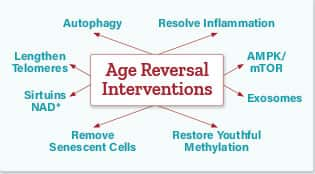
In 1980, Life Extension® began publishing a newsletter that described methods to reduce one’s risk of degenerative disorders.
Back in those early days, we advocated controversial positions relating to cardiovascular disease prevention. These included lower reference ranges for blood glucose, lipids, and blood pressure that are now recognized by the medical establishment.
Compared to our first publication 41 years ago, we are light-years ahead in our knowledge of what causes aging and how to partially forestall it.
I am actively engaged and donate monies to find ways to reverse aging in elderly persons.
Your support helps fund this clinical research aimed at benefiting all of humanity.
The accumulation of cellular waste products interferes with vital body functions needed to sustain life.
There are now ways to remove this toxic debris that clogs healthy cellular functions via a natural process called autophagy.
The boxes on the right are from live presentations I give to describe age-reversal research, including projects that relate to boosting cellular autophagy.
For longer life,
William Faloon, Co-Founder
Life Extension Buyers Club
References

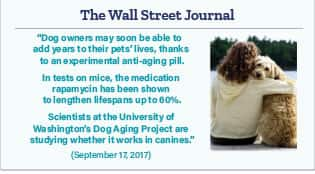
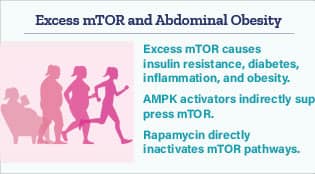
- Harrison DE, Strong R, Sharp ZD, et al. Rapamycin fed late in life extends lifespan in genetically heterogeneous mice. Nature. 2009 Jul 16;460(7253):392-5.
- Zhang Y, Bokov A, Gelfond J, et al. Rapamycin extends life and health in C57BL/6 mice. J Gerontol A Biol Sci Med Sci. 2014 Feb;69(2):119-30.
- Bjedov I, Toivonen JM, Kerr F, et al. Mechanisms of life span extension by rapamycin in the fruit fly Drosophila melanogaster. Cell Metab. 2010 Jan;11(1):35-46.
- Lind MI, Chen HY, Cortazar-Chinarro M, et al. Rapamycin additively extends lifespan in short- and long-lived lines of the nematode Caenorhabditis remanei. Exp Gerontol. 2017 Apr;90:79-82.
- Flynn JM, O’Leary MN, Zambataro CA, et al. Late-life rapamycin treatment reverses age-related heart dysfunction. Aging Cell. 2013 Oct;12(5):851-62.
- Hamano T. Klotho upregulation by rapamycin protects against vascular disease in CKD. Kidney Int. 2015 Oct;88(4):660-2.
- Anisimov VN, Zabezhinski MA, Popovich IG, et al. Rapamycin extends maximal lifespan in cancer-prone mice. Am J Pathol. 2010 May;176(5):2092-7.
- Spilman P, Podlutskaya N, Hart MJ, et al. Inhibition of mTOR by rapamycin abolishes cognitive deficits and reduces amyloid-beta levels in a mouse model of Alzheimer’s disease. PLoS One. 2010 Apr 1;5(4):e9979.
- Johnson SC, Rabinovitch PS, Kaeberlein M. mTOR is a key modulator of ageing and age-related disease. Nature. 2013 Jan 17;493(7432):338-45.
- Available at: https://www.cnn.com/2016/10/06/health/rapamycin-dog-live-longer/index.html. Accessed December 18, 2020.
- Bitto A, Ito TK, Pineda VV, et al. Transient rapamycin treatment can increase lifespan and healthspan in middle-aged mice. Elife. 2016 Aug 23;5.
- Available at: https://nypost.com/2019/11/14/scientists-looking-for-10000-dogs-to-study-aging/. Accessed December 18, 2020.
- Evangelisti C, Cenni V, Lattanzi G. Potential therapeutic effects of the MTOR inhibitors for preventing ageing and progeria-related disorders. Br J Clin Pharmacol. 2016 Nov;82(5):1229-44.
- Bjedov I, Rallis C. The Target of Rapamycin Signalling Pathway in Ageing and Lifespan Regulation. Genes (Basel). 2020 Sep 3;11(9):1043.
- Mizushima N, Levine B, Cuervo AM, et al. Autophagy fights disease through cellular self-digestion. Nature. 2008 Feb 28;451(7182):1069-75.
- Levine B, Kroemer G. Autophagy in the pathogenesis of disease. Cell. 2008 Jan 11;132(1):27-42.
- Madeo F, Zimmermann A, Maiuri MC, et al. Essential role for autophagy in life span extension. J Clin Invest. 2015 Jan;125(1):85-93.
- Rubinsztein DC, Marino G, Kroemer G. Autophagy and aging. Cell. 2011 Sep 2;146(5):682-95.
- Mattson MP, Longo VD, Harvie M. Impact of intermittent fasting on health and disease processes. Ageing Res Rev. 2017 Oct;39:46-58.
- Available at: https://clinicaltrials.gov/ct2/show/NCT04608448. Accessed December 18, 2020.
- Available at: https://clinicaltrials.gov/ct2/show/NCT04488601. Accessed December 18, 2020.
- Available at: https://clinicaltrials.gov/ct2/show/NCT03103893. Accessed December 18, 2020.
- Available at: https://clinicaltrials.gov/ct2/show/NCT02874924. Accessed December 18, 2020.
- Available at: https://clinicaltrials.gov/ct2/show/NCT01649960. Accessed December 18, 2020.
- Available at: https://clinicaltrials.gov/ct2/show/NCT00891696. Accessed December 18, 2020.
- Available at: https://clinicaltrials.gov/ct2/show/NCT00304954. Accessed December 18, 2020.
- Available at: https://www.longevity.technology/agelessrx-and-funding-an-irb-approved-rapamycin-trial/. Accessed December 18, 2020.
- Glynn P, Lloyd-Jones DM, Feinstein MJ, et al. Disparities in Cardiovascular Mortality Related to Heart Failure in the United States. J Am Coll Cardiol. 2019 May 14;73(18):2354-5.
- Mao Z, Zhang W. Role of mTOR in Glucose and Lipid Metabolism. Int J Mol Sci. 2018 Jul 13;19(7).
- Available at: https://www.lifeextension.com/magazine/2000/11/report_lemix. Accessed December 18, 2020.
- Imran M, Rauf A, Abu-Izneid T, et al. Luteolin, a flavonoid, as an anticancer agent: A review. Biomed Pharmacother. 2019 Apr;112:108612.
- Lin Y, Shi R, Wang X, et al. Luteolin, a flavonoid with potential for cancer prevention and therapy. Curr Cancer Drug Targets. 2008 Nov;8(7):634-46.
- Data on file.
- Xu J, Wang H, Lu X, et al. Posttraumatic administration of luteolin protects mice from traumatic brain injury: implication of autophagy and inflammation. Brain Res. 2014 Sep 25;1582:237-46.
- Bramlett HM, Dietrich WD. Long-Term Consequences of Traumatic Brain Injury: Current Status of Potential Mechanisms of Injury and Neurological Outcomes. J Neurotrauma. 2015 Dec 1;32(23):1834-48.
- Verschooten L, Barrette K, Van Kelst S, et al. Autophagy inhibitor chloroquine enhanced the cell death inducing effect of the flavonoid luteolin in metastatic squamous cell carcinoma cells. PLoS One. 2012;7(10):e48264.
- Insilico Medicine - Data on File. 2020.
- Zhang X, Zhang QX, Wang X, et al. Dietary luteolin activates browning and thermogenesis in mice through an AMPK/PGC1alpha pathway-mediated mechanism. Int J Obes (Lond). 2016 Dec;40(12):1841-9.
- You Y, Wang R, Shao N, et al. Luteolin suppresses tumor proliferation through inducing apoptosis and autophagy via MAPK activation in glioma. Onco Targets Ther. 2019;12:2383-96.
- Liu J, Liu W, Lu Y, et al. Piperlongumine restores the balance of autophagy and apoptosis by increasing BCL2 phosphorylation in rotenone-induced Parkinson disease models. Autophagy. 2018;14(5):845-61.
For longer life,
William Faloon

